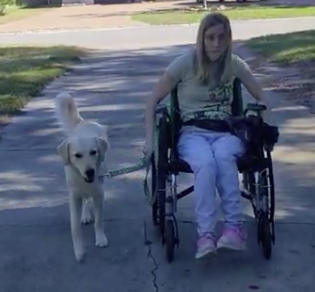People with disabilities, whether physical or psychological, are accustomed to work arounds in every aspect of life – adaptations or modifications that empower us to accomplish our goals despite whatever limitations we may experience. ELLAS Animals INC specializes in teaching people with disabilities how to train their own service dogs, and this necessitates a fluid approach, adapting service dog training to a trainer’s disability. Today’s guest blogger, Katie Calahan, shared her experience a few months ago of beginning with a new puppy and how she was learning to modify the training techniques to ensure she and her puppy would achieve success on their journey to become a service dog team. Today she offers an update on how that training is going and the additional challenges they face training a service dog from a wheelchair.

Update by Katie Calahan
Daisy, a golden retriever, is now a year and two months old and weights 60 pounds! We’re in the self-assessment stage of ELLAS Animals INC’s Foundational Obedience course. Heel is still our biggest challenge, but we have found our groove for walks. Here’s what we learned about training a service dog from a wheelchair:
- Don’t over do it. Not only do we attempt to work one “D” (Distance, Duration, Distractions) at a time, but more importantly for us, we have to check in with ourselves. Am I tired, in pain, under a time constraint? Is Daisy super high energy, distracted or not feeling well? We adjust our geographical path to what we can handle for each walk. This also keeps Daisy mentally stimulated and allows me to introduce training in different environments.
- Be grounded. As Daisy grew I began walking her from the wheelchair exclusively. I also had to try several different waist leashes to find the one that works best for us on daily walks. Now balance issues are not in play because I’m grounded in my sit-bones and relying on my upper body strength, which is a major point when training a service dog from a wheelchair.
- Tools. Along with the waist leash which will always be in play for us, we also used a Gentle Leader for training. It was invaluable for getting Daisy to focus on a walk and eliminated pulling all together while it was on. As she grew and it stopped fitting, we were able to forgo the Gentle Leader and communicate through leash length and tension or commands more easily.
- Concentrate on commands that keep us safe. We work the heel/sit, leave it and wait commands every single walk. Daisy has a good entrance/exit procedure and a getting ready to cross the road procedure. It was hard for me to wrap my head around not doing everything in course order at first, but I had to take stock of what my dog and I needed. Being a good team and staying safe are always the priority, whether training a service dog from a wheelchair or not.
- Patience. My biggest challenge! Humans and dogs have bad days. It doesn’t erase your success to have a rough walk, have to review a skill because of regression, or to ask for help! Please, have faith that the work you’re doing will produce these skills in time.

A note about realistic expectations when training a service dog from a wheelchair:
Daisy and I still have bad walks and experiences. Right before Thanksgiving I took her to our wonderful groomer, whom she adores. I knew she’d be in an extreme state of excitement, but we only had to make it a few feet from the car to the door. I was a little nervous and rushed the exit procedure from car. She jumped down and calmly sat but did not wait for her heel command and sprang toward the door. I was on foot so I went down. I recovered by commanding a sit and, from a comfortable position, called the groomer to meet us. With the groomer as back up, Daisy walked calmly inside (and then jumped all over her!).
I worked some commands prior to dropping her off for her Christmas grooming the following month and brought my husband for back up, took my time with car exit allowing Daisy some time to settle down, and (although Daisy was still extremely excited) there were no incidents. There are learning opportunities everywhere.
Sometimes you have to ignore the judgmental by-standers when you’re training a service dog from a wheelchair
We had a walk last month through a busy park. I was in the wheelchair with the waist leash. Daisy was holding her own with all the distractions. I was issuing commands so that sometimes we walked calmly past dogs or people and sometimes I had her sit and wait for them to pass. She was doing pretty well. At the mid-point of our journey an older man remarked that she was “giving me a hard time” and then began talking/scolding her directly. I politely said “she’s doing her best; she’s still learning.” At which point this gentleman turned to me and said in the most judgmental tone I’ve heard in a long time, “So You’re TRAINING a service dog from a WHEELCHAIR.”
I must admit, I was stunned. As a person with a visible physical disability strangers’ judgement is not completely foreign, but I was not prepared in this moment. I simply replied “yes.” Of course, Daisy had an excited moment shortly after, while this man was still watching, and she got wound up about a squirrel while I was on uneven ground and distracted throwing the poo bag away and tipped the wheelchair over. I was fine and got control of Daisy quickly, but I was thoroughly embarrassed. As onlookers expressed concern and the already judgmental man looked on I gathered myself and moved on walking the opposite direction away from the crowd that had gathered. It’s hard, when you’re already judging yourself, to be judged, but he was a stranger – an ablest, ignorant stranger with no investment in the future of myself or my dog. Once in a while there are set backs, we just have to press on. It’s reasonable for a one-year-old puppy who has been sitting patiently for poop pick-up amidst park level distractions to forget herself and lunge at a nearby squirrel. She recovered and obeyed commands for the better part of the walk and I learned a lesson about stopping on uneven ground with my back to the dog.
Stay the course, friends! Do what works for you and your dog. Stay safe, keep learning, and ask for help! You can succeed in training a service dog from a wheelchair or whatever other accommodations you need to make!

Guest Author – Katie Calahan: I’m an actress/writer/director and run a local children’s theater program. I received my classical training and my BFA in Theatre Studies from Boston University. I’m a native Floridian (We DO Exist!), but I’ve lived in Boston, New York, Dublin and LA. I’m currently based in the good old sunshine state, but more than happy to travel. I love an adventure! I love Shakespeare, dessert, kayaking, Bob’s Burgers, a great book, Disney and my golden retriever!

Nothing in ELLAS Animals INC’s website or blog is intended as medical, legal, or financial advice. We receive no compensation for recommendations or reviews.

Thanks for article. Trying to decide on training a pup to be a service dog or working with a non profit that has trained service dog 2 years old. I’m a dog mom of 30 years. Wheelchair traveler of 10 years. Dog less 2 years.
Great! Best of luck with your decision. Let us know if you have any questions.
I would recommend getting an already trained service dog vs training a pup.
I say this from experience. I went and trained with my finished service dog as is required. Eince already knew his obedience and service dog tasks, it was simple to add the wheelchair to the mix.
He passed away from old age. 3 years later, I have now raised a 1!year old pup. We are in a program together. Trouble is, in a wheelchair, you need both hands on the wheels. With a new dog, you need at least one hand on the dog.
If the dog does not heel, sit, or otherwise listen to you for whatever reason, you have to choose between your hands on your wheels or your chair will be doing what it wants while you tru to redirect your dog.
I have found, with my first service dog, that everyone has advice for you and your dog (yes even a finished one). They are not in a wheelchair and they are not truing to train a distracted pup. 1 yr old dogs are pups. They should be working on their Good Citizen K9, not wheelchair training or finish work. Every one who will give you advice will NOT be in a wheelchair. They may be dog trainers or people who have trained their own dog. Not one of them has ever been in an ADA bathroom where you cannot move your chair around to position yourself to use the toilet. Yet they will give you advice on how nice ADA bathrooms are.
The group program I am in, I am the only wheelchair person. When we walk in a circle counter clock wise, with dogs who are not trained to heel, it is a disaster.
The trainers walk up, touch your dog and give them treats. What does your pup learn? I can take food from anyone.. i can ask for attention from anyone. i would rather go to that nice person to get a handful of treats for doing nothing than learn anything. The dog only sees a person with trwats. They are not training your dog. You cannot correct your dog because they are trainers. Therefore, strangers are good, they have treats.
I have worked very hard to teach my pup not to eat ground food or take food or attention from strangers or (anyone).. in one day my pup learned that strangers randomly come up and feed treats. (They were noy training him just feeding him treats – more than one trainer did this)
My point of view is they are distracting my dog from the training and from me (who is training him).
Dogs point of view: free treats! YUM!
Dog does not know this person is a trainer.
Dog learned taking food from strangers is fine. Taking food from the ground is fine. Person with treats are wonderful. I should pay more of attention to them (=more treats! ) and no obedience or work required.
So, now my dog learned several thing he shoukd not have learned and nothing new. 6 commands in one hours. The dogs all were confused anf over stimulated
It will take me a week to untrain him from seeking out strangers for treats.
I just don’t know if I am up for this – it is difficult enough to train him, without this redirection to a person with treats who is not training the dog.
I dont know how I am going to solve my problem. I have to let the evenfa sink in and, knowing my pup, retrain accordingly.
Thank you for sharing your perspective.